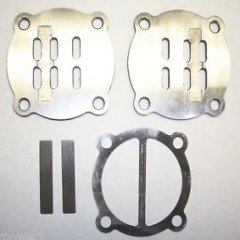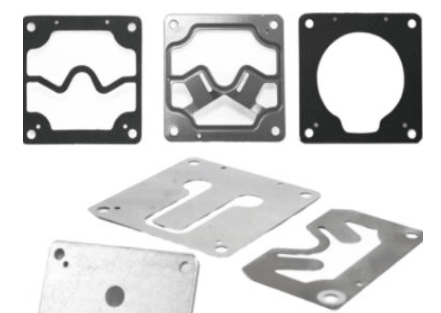What does it mean when there is air blowing out of intake on an air compressor, and how do you fix this? This article will provide you with all the relevant information on why air is blowing out of your air compressor intake valve, and a solution to fix it!
Table of Contents
- Air Compressor Blowing Air Out of Intake Valve
- The Air Compressor Intake Valve Problem Solution
- FAQs (Frequently Asked Questions)
- Reader Comments & Responses
Air Compressor Blowing Air Out of Intake Valve
Air compressors blowing air out of their intake valves is a very common issue. The easiest way to pick up on this issue is if the compressor is taking far longer to reach its normal cut-out pressure than usual. The time change from when the compressor had no issue with what it is displaying now will get greater as the problem intensifies. For more information on Why An Air Compressor Won’t Build Pressure & How To Fix A Compressor Not Building Pressure visit our guide here!
Or, it’s possible that the compressor may never get to the normal cut-out pressure setting. That will lead to other issues, including the motor perhaps shutting itself down on thermal overload due to overheating. This also may result in the premature wear of components and a reduction in the lifespan of the compressed air system, hence why it is so important to discover and fix it as soon as possible!
Most air compressors have some sort of air intake valves. Their shape, design, and location on the compressor will vary as there are a host of air compressors on the market, from fractional HP DIY up to compressors with hundreds of HP electric motors.
The following image is that of a Campbell Hausfeld air compressor valve plate kit. The two strips seen in the image at the bottom left are the valves, one being the intake valve and the other the high-pressure valve.

The purpose of the intake valve in the air compressor pump is to open to allow air into the compression area of the pump when air is to be drawn into it and then to close to prevent that air from escaping when the pump moves into its compression cycle.
How each air compressor compresses air will vary depending on the type of compressor, but in every case, once the air is pulled into the pump, it should not get back out of the intake valve. In general, the intake valves are those thin metal flaps that are mounted on the valve plate.
Depending on your air compressor the air intake valves may vary, the small DIY air compressor has two valve plates, otherwise known as reed valves, that are placed between a pair of gaskets. The low-pressure valve helps to control the air intake into the cylinder, entering from the intake filter, while a high-pressure HP valve helps the air to head downwards the tank.
For more information on reed valves, visit our reed valve troubleshooting & make your own reed valve articles!
They work in tandem with the discharge, as the piston moves down inside the compressor, atmospheric air is drawn in and pushes open the inlet valve as part of the vacuum that is created. When the piston then moves up, the air is compressed and pushes the discharge open to move to the tank while the inlet is held closed.
When air comes out of the compressor intake while the air compressor pump is running, it indicates that the intake valve is failing, or has failed completely. To make sure that this is the case, you can remove the intake filter, then run your compressor while carefully checking around its intake port. If you feel air pumping from this port then it is more than likely that your intake valve is failing and needs replacing.
The Air Compressor Intake Valve Problem Solution
It is time to tear down the pump to repair or replace the intake valve.
Before starting that job, however, use Google and search for spare parts for… your compressor make and model number. Many lower-cost DIY type air compressors use common valve plate kits, and you may get lucky and find one for not a lot of money.
On the other hand, you may not find a kit for your compressor at all, and that will lead you to make your own valves. This may not be too difficult for most, and you can see how by reading that page on this site.
A strong suggestion for you; if you need to replace the valve plate, and your existing pump has gaskets in and around the valve plate, you might as well replace the gaskets while you have the pump apart, as leaking gaskets are another common cause of air compressors that run and run, but don’t build pressure as fast as they used to, or don’t build air pressure at all.
FAQs (Frequently Asked Questions)
In most cases, when air is coming out of the intake air filter will indicate that the valve plate is broken. The valve plate, when working properly, should keep the air from coming out of the intake so that the piston can force the air into the tank. To inspect the valve plate you will need to remove the covers on the motor to access the pump head.
An air compressor inlet valve works by regulating the capacity of air being sucked into your compressor. The inlet valve’s job is to draw air into the compressor to flow into a chamber where the air is compressed. The inlet valve is often followed by a filter to protect the compression system from having contaminants enter it.
An air intake valve, otherwise known as an air inlet valve, is a component of an air compressor that represents the first stage of the compression process. The inlet valve sucks in air from the atmosphere before it’s passed through a filter and then into the compression chamber.
If air compressor valves become defective, it is likely that air will release from the system and the compressor won’t be able to provide the desired pressure of air. This can happen due to various valves found in a compressed air system, including the check valve, unloader valve, and intake valve. If the compressor is losing pressurized air, it may not reach its cut-out pressure and therefore will exceed its designed cycle time, causing potential overheating of the motor and premature wear.
The air intake and discharge valves can be found at the top of the cylinder in an air compressor. They are thin metal flaps that are mounted underneath (one) and on top of the valve plate (the other). As the piston moves down, atmospheric air is drawn in and pushes open the inlet valve as part of a vacuum. When the piston then moves up, the air is compressed and pushes the discharge open to move to the tank while the inlet is held closed.
Reader Comments & Responses
Should My Intake Valve Be Blowing Air Out?
Question
I changed all the gaskets even change the oil and still no pressure.
The air is blowing out the intake valve and also the oil fill cap. Did I do something wrong?
Response
Not knowing the make and model makes responding a bit difficult, friend.
I would surmise from your post that when you reassembled the compressor pump you may have installed the valve plate reversed from what it is supposed to be.
So, when the piston is cycling, the air is being pulled in from the tank (not much of which can happen due to a check valve on the tank) and is being blown out of the intake.

As to air coming out of the oil fill cap, if you can feel that happening, that is an indication of extreme wear on the piston seal(s) and enough air is bypassing the piston as it cycles to blow out the vent.
Note that the oil cap is vented to allow any air bypassing the piston seals not to pressurize the oil sump area, yet it sounds as though you have an extreme case.
Question
Do you think that the problem could be due to oil excessively sticky?
The compressor has always worked alright but it has not been used for quite a long time.
I decided to drain the oil and found it quite sticky. Now I do not know if it is a characteristic of the oil or which kind of oil should be used (I guess 15W50 could be one) but strange enough it stopped making the usual sound and sounds like stuck, humming. And it blew from the inlet.
Thanks, Rob
Response
There should not be a lot of oil in the compressor valve area, Rob. If there is, that suggests that the piston seals aren’t up to snuff.
Too sticky oil? Hmmm, as long as you are using compressor lubricating oil, so named and sold as such almost everywhere that sells compressors, you should be OK.
Air should not be coming out of the intake. I still think you have a valve problem with this compressor.
Compressor Will Not Build Pressure?
Question
I think the reed valve is not sealing, but it looks okay. Everything in the head looks clean and in good shape. The piston has good suction. What can I do to repair it if it all looks good?
Response
Howdy Mark. When the compressor is running, is there a puffing or a pulse of air out the intake valve? You might pull the intake filter and carefully place your finger near the intake port to feel if there is pressure. If no air is coming out, then logically the only place the compressed air can go is into the tank.
Now, assuming that there is no mechanical issue with your compressor, then why isn’t the pressure rising? Well, if you have a gasket failure inside the compressor head, then the air is simply moving back and forth inside, and not getting pushed into the tank at all.
I suspect that may be the reason why your air compressor will not build pressure.
Questioner
Found the problem!
When I posted my original question, I thought that everything in the head looked good but I did not realize that there was another gasket and spacer still stuck to the head when I removed it.
I removed the spacer and gasket and found that the gasket was blown out between the intake and exhaust ports. I made a gasket from cheap gasket material and it has been working well for over a month.
Compressor Will Not Build Pressure?
Question
Roebuck, sc 29376. The compressor blows air out the filter on top of the compressor and will not build pressure above 50 psi.
Response
If it is the intake port that is blowing air out when the compressor is running it would suggest to me that your intake valve has failed, and your compressor is pulling air in, and then some of it is blowing back out the intake port, and not compressed into the tank.
At 50 PSI, the intake and out-blow seem to be almost equal, and the pressure won’t get any higher than that despite how long the compressor runs.
If you have any questions regarding air blowing out the intake, please leave a comment below, with a photo if applicable, so that someone can help you!
